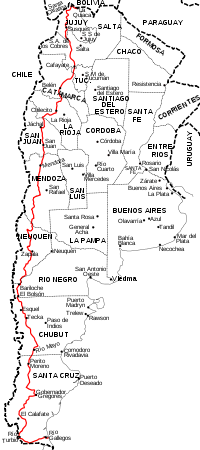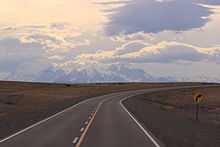- National Route 40 (Argentina)
-
National Route 40 or RN40, often called Ruta 40 even in English texts[1], is a route in western Argentina, stretching from Cabo Virgenes in Santa Cruz Province in the south to La Quiaca in Jujuy Province in the north, running parallel to the Andes mountains. The southern part of the route, a largely paved road through sparcely populated territory, has become a well-known adventure tourism journey.
Route 40 is the longest route in Argentina and one of the largest in the world (along with the U.S. Route 66 and the Stuart Highway in Australia -without counting the unofficial Panamerican Highway-) [2][3][4], more than 5,000 km (3,107 mi) long. At its traditional southern end near the city of Río Gallegos it starts at sea level, crosses 20 national parks, 18 major rivers, 27 passes on the Andes, and goes up to 5,000 m (16,404 ft) above sea level in Abra del Acay in Salta.
The road crosses the provinces of Santa Cruz, Chubut, Río Negro, Neuquen, Mendoza, San Juan, La Rioja, Catamarca, Tucumán, Salta and Jujuy.
Contents
Description
Incorporation of sections of other highways into Route 40, along with paving, is part of an Argentine government initiative to promote national tourism, drawing upon the legendary and some say mythical attraction attached to Route 40. The attraction is actually international in scope, and many websites throughout the world advertise the private and commercial adventures associated with travel on this roadway.
There are a number of internationally important sites along this route, such as Cueva de las Manos, which contains cave art dating back some 13,000 years, Los Glaciares National Park, the second largest National Park in Argentina, and the Calchaquí Valleys.
North
RN40 begins at the Bolivian border at La Quiaca. From there it goes west to San Juan de Oro, then turns south, parallel to the Andes, by San Antonio de los Cobres and Cachi and through the Calchaquí Valleys to Cafayate, then via Belén, Villa Unión to San Juan. From San Juan RN40 is a busy highway to Mendoza.
South
From Mendoza RN40 continues south to Pareditas, Malargüe, Chos Malal and Zapala. It takes a route to the east of Bariloche to El Maitén and a junction with RN258 at Leleque. It then passes near Esquel and continues by Tecka, José de San Martín and Alto Río Senguer to a junction with the RN43 at the town of Perito Moreno.
The road then enters the most remote part of its route. 124 km south of Perito Moreno is a junction with a side road to Cueva de las Manos, and 3 km further is the tiny settlement of Bajo Caracoles (population 100).[5] After a further 101 km there is a junction with a road to Perito Moreno National Park, but no habitation apart from a police station and later an estancia until the small town of Tres Lagos, some 235 km further south. From Tres Lagos the road is paved to a junction 32 km east of El Calafate and another junction at El Cerrito, where RN40 leaves the main highway to Rio Gallegos. The route then takes a roundabout route to Rio Gallegos through the town of 28 de Noviembre, where it turns east to follow the valley of the Gallegos River. It reaches the Atlantic coast at Punta Loyola, 36 km from Rio Gallegos.
History
Since the beginning of its construction in 1935, the route has changed several times. On 24 November 2004 the Argentine national directorate of highways (Dirección Nacional de Vialidad) promulgated Resolution 1.748/04 which changed the milestone markings and placed the "zero" kilometer stone at the new southernmost extreme of the road, at Cabo Virgenes, near the Straits of Magellan.[6] Since as of January 2009 there was no actual roadway constructed between the new marker location at Cabo Virgenes and Punta Loyola (near Río Gallegos) the provisional driving starting point as of early 2009 was at the KM 100 location. Before 2004, Route 40 was divided into "Ruta 40 Sur" (south) and "Ruta 40 Norte"(north) with the earlier "traditional" zero-km starting point at the intersection of San Martín and Garibaldi streets in the city of Mendoza, in Mendoza province. That zero-km marker was subsequently moved to the eastern access point of that city, at the intersection of Route 7 and Gob Avenue. Ricardo Videla (also known as Avenida Costanera). The intent of new legislation and remarking of roadways will move the traditional northern terminus of Route 40 to the frontier with Bolivia near the location of Ciénaga de Paicone.
Latest developments
On 20 May 2006 the Argentine national highway directorate and the Jujuy provincial highway department signed an agreement in which sections of Jujuy provincial highways 85, 70, 74, 7, 64, 65, and 5 were transferred to national control for the construction of the so-called "Mining Corridor" which will become the new path of Route 40, more toward the west in that province. The agreement was ratified by provincial law 5520. Accordingly the section of the road between San Antonio de los Cobres and Abra Pampa is renamed National Route 1V40.
On February 2009, president Cristina Kirchner announced that the remaining unpaved length of the route in Santa Cruz was going to be paved.[7]
References
- ^ e.g. South American Handbook 2009 ISBN 978 1 906098 36 0 p.230
- ^ http://www.guiaverde.net/cambalache/terminar-la-ruta-40-ahora-cuesta-el-doble.htm
- ^ http://www.lanacion.com.ar/nota.asp?nota_id=1122178
- ^ http://www.lacapitalmdp.com/noticias/La-Ciudad/2009/09/17/121139.htm
- ^ South American Handbook 2009,p.247
- ^ La Nación, 2009-04-26
- ^ La Nación, 2009-04-26
External links
- Official Site
- (Spanish) Route 40 - Argentine longest
- (Spanish) Terminar la ruta 40 ahora cuesta el doble (To finish route 40 now costs double), La Nación, April 26th 2009 Retrieved 2009-04-26
National Roads in Argentina 1 · 3 · 5 · 7 · 8 · 9 · 11 · 12 · 14 · 16 · 18 · 19 · 20 · 22 · 23 · 25 · 26 · 33 · 34 · 35 · 36 · 38 · 40 · 50 · 51 · 52 · 60 · 64 · 65 · 66 · 68 · 74 · 75 · 76 · 77 · 78 · 79 · 81 · 86 · 89 · 95 · 98 · 101 · 105 · 117 · 118 · 119 · 120 · 121 · 122 · 123 · 127 · 130 · 131 · 135 · 136 · 141 · 142 · 143 · 144 · 145 · 146 · 147 · 148 · 149 · 150 · 151 · 152 · 153 · 154 · 157 · 158 · 168 · 173 · 174 · 175 · 177 · 178 · 188 · 193 · 205 · 226 · 228 · 229 · 231 · 232 · 234 · 237 · 242 · 249 · 250 · 251 · 252 · 259 · 260 · 281 · 288 · 293
 Categories:
Categories:- Roads in Argentina
Wikimedia Foundation. 2010.




